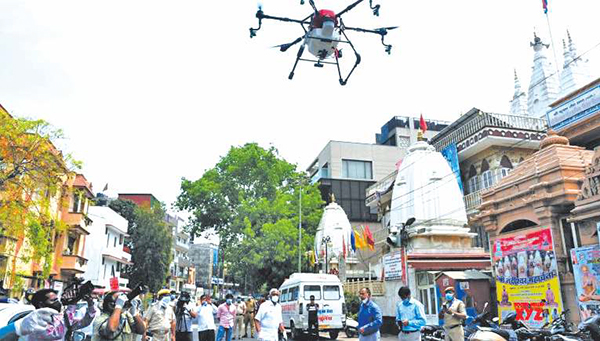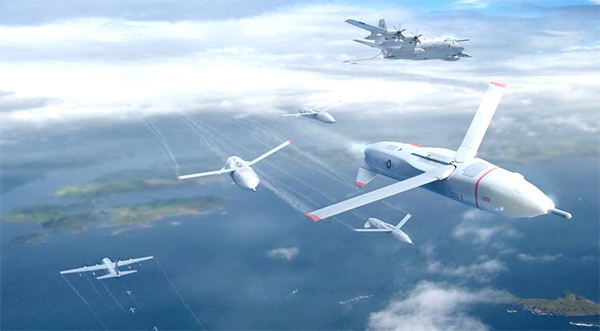In a bid to provide fast track conditional exemptions to government agencies for Covid-19 related remotely piloted aircraft system (RPA)/ drone operations, aviation authorities have launched a Garud portal.
Conditions have been laid down in case of such exemption for aerial surveillance, aerial photography and public announcements related to Covid-19. Exemption is limited to battery-operated rotary-wing RPAs. Use of any other type of RPA, including but not limited to, fixed-wing RPA and autonomous RPA etc. is strictly prohibited.
Details of every RPA flight will be uploaded on Director General Civil Aviation (DGCA) Digital Sky Platform within seven days of undertaking the flight. Any incident or accident related to any RPA operation shall be immediately reported to Ministry of Civial Aviation (MoCA) and DGCA through the Digital Sky Platform.
The RPA will have a Unique Identification Number (UIN) and/or Drone Acknowledgment Number (DAN) issued by DGCA; not exceed a total all-up weight of 25 kg; equipped with an automatic return-to-home feature in case of any loss of the command-and-control link; restricted to a height of 200 feet Above Ground Limit (AGL); operated within visual line of sight (VLOS) at all times; operated while maintaining safe distance from people, buildings, vehicles and property at all times; not pick, drop, spray or discharge any substance; restricted to a period between local sunrise and local sunset.
Safety and security distances have also been laid down – not within a distance of 5 km from the perimeter of airports at Mumbai, Delhi, Chennai, Kolkata, Bengaluru and Hyderabad; not within a distance of 3 km from the perimeter of other civil, private or defence airports; not within permanent or temporary Prohibited, Restricted and Danger Areas including Temporary Reserved Airspace (TRA), and Temporarily Segregated Areas (TSA), as notified in the Aeronautical Information Publication (AIP); not within 25km from international border which includes Line of Control (LoC), Line of Actual Control (LAC) and Actual Ground Position Line (AGPL); beyond 500 m (horizontal) into sea from coast line provided the location of ground station is on fixed platform over land; not within 3 km from perimeter of military installations/ facilities/ where military activities/ exercises are being carried out unless clearance is obtained from the local military installation/facility; not within 5 km radius from Vijay Chowk in Delhi. This is subject to additional conditions/ restrictions imposed by local law enforcement agencies/ authorities; not within 3 km radius from State Secretariat Complex in State Capitals; and not within 2 km from perimeter of strategic locations/vital installations notified by Ministry of Home Affairs (MHA).
‘Pandemic Drone’ to Detect Coronavirus
A ‘pandemic drone’ to remotely monitor and detect people with infectious respiratory conditions is being developed by the University of South Australia (UniSA) in partnership with a Canadian company.
The drone will be fitted with a specialised sensor and computer vision system that can monitor temperature, heart and respiratory rates, as well as detect people sneezing and coughing in crowds, offices, airports, cruise ships, aged care homes and other places where groups of people may work or congregate.
The UniSA team led by Defence Chair of Sensor Systems Professor Javaan Chahl, who holds a joint appointment DST, will work with Draganfly Inc, a North American drone technology company, to immediately start integrating commercial, medical and government customers.
Professor Chahl, working alongside Dr Ali Al-Naji and Asanka Perera, achieved global recognition in 2017 when they demonstrated image-processing algorithms that could extract a human’s heart rate from drone video.
Since then they have demonstrated that heart rate and breathing rate can be measured with high accuracy within 5-10 metres of people, using drones and at distances of up to 50 metres with fixed cameras. They have also developed algorithms that can interpret human actions such as sneezing and coughing.
He says the technology could be a viable screening tool for the Covid-19 pandemic.
MSMEs Can Get UAV Projects
MSMEs in drone manufacturing have found the going difficult and with the pandemic melt down of the manufacturing in India, may require impetus more than ever to remain commercially viable.
While the Defence Research and Development Organisation (DRDO) has been trying to indigenize these, the private sector UAV industry has been growing. Unfortunately the evolution of technology has been restricted due to ambiguity in implementation of Drone Regulations promulgated by Airport Authority of India (AAI).
In a letter to the Ministry of Defence (MoD) Society of Indian Defence Manufacturers (SIDM) has requested for a directive to be issued to the DRDO, Ordnance Factory Board (OFB), defence public sector undertakings (DPSUs) and the Services to prepare a list of projects that can shared with the private sector companies and the MSMEs.
DRDO’s long range multi-mission drone, Rustom-2 has been under development since 2011, even after realizing multiple airframes and Design Validation Flights (DVF) by 2017 itself, there have been delays to meet the User’s requirements.
In the mini UAVs category, Netra is a Quadcopter developed by DRDO with Private industry Partnership and could be supplied to Police and Para military services, even Indian Army exploited these drones but technological advancement pushed for upgradation of these mini UAVS.
Due to restrictions in explosive ordnance handling by commercial agencies, the design and development of unmanned combat aerial vehicles (UCAVs) for attack role have been limited in India. India’s first weaponized drone was undertaken by National Security Guards (NSG) in 2018. A private MSME completed the successful development and subsequent manufacture trials of ‘Kamikaze’ explosive laden mini-Quadcopter drones. However, due to complicated procurement procedures has not been inducted yet.
Overall, the armed forces are still dependent on import of UAVs for operational missions, and is spending dollars for maintenance like spares, annual maintenance contracts (AMC) signed with the original equipment manufacturers (OEM), etc, as India has not been able to manufacture any indigenous UAVs.
IAF Interested in Swarm Drones Launched From Aircraft
The US Defense Advanced Research Projects Agency (DARPA) has been researching several types of swarm drone technology that could be used on the battlefield. According to Pentagon acquisition head Ellen Lord, one particular programme has impressed the Indian Air Force (IAF) due to which US and India have discussed collaborating on such efforts to build a relatively low-cost unmanned aircraft that can be launched from a “mother ship” transport aircraft like C-130J which IAF already has in its fleet and then be recovered by the same mother ship after their mission is complete.
The IAF also wants to include other “mother ship” transport aircraft like its C-17 fleet and primarily talks were held last year about collaboration between US Air Force Research Laboratory and DRDO. Further talks will likely be held later in 2020 to work on the technicality of the proposed joint venture.
According to DARPA’s concept, a jet-powered drone can be launched from the C-130 wing pylons and recovered by using a docking cable and a crane-like recovery arm from the cargo door. DARPA is looking at the drones that can be used as a potential line-of-sight communications link in contested environments where radios could be jammed, as well as use its sensor platforms for surveillance and targeting.
Each C-130J will be able to launch 4 such Jet powered SWARM drones which can be tasked to perform specific individual tasks and interact with each other using autonomous mode and all can be recovered within 20 minutes.



















